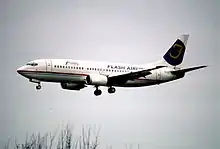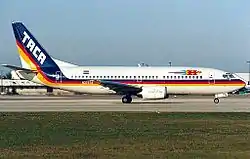Flash Airlines Flight 604
Flash Airlines Flight 604 was a charter flight provided by Egyptian private charter company Flash Airlines. On 3 January 2004, the Boeing 737-300 that was operating the route crashed into the Red Sea shortly after takeoff from Sharm El Sheikh International Airport, killing all 135 passengers, most of whom were French tourists, and all thirteen crew members.[1] The findings of the crash investigation were controversial, with accident investigators from the different countries involved unable to agree on the cause of the accident.
 SU-ZCF, the aircraft involved in the accident, seen in March 2002 | |
| Accident | |
|---|---|
| Date | 3 January 2004 |
| Summary | Cause disputed:
|
| Site | Red Sea, near Sharm El Sheikh Int'l Airport, Sharm El Sheikh, Egypt 27°50′N 34°23′E |
| Aircraft | |
| Aircraft type | Boeing 737-3Q8 |
| Aircraft name | Noar |
| Operator | Flash Airlines |
| Registration | SU-ZCF |
| Flight origin | Sharm El Sheikh Int'l Airport Sharm El Sheikh, Egypt |
| Stopover | Cairo International Airport Cairo, Egypt |
| Destination | Charles de Gaulle Airport Paris, France |
| Occupants | 148 |
| Passengers | 135 |
| Crew | 13 |
| Fatalities | 148 |
| Survivors | 0 |
Flight 604 was the deadliest air disaster in Egypt until it was surpassed almost twelve years later by the bombing of Metrojet Flight 9268.[2][3] It remains the deadliest accident involving a 737 Classic aircraft.[4]
History of the flight
Aircraft and crew

The accident airplane was a Boeing 737-3Q8 powered by two CFM56-3 engines. It was built and delivered to TACA International Airlines as N373TA in October 1992, and had been operated by Flash Airlines since June 2001. At the time of the accident it had accumulated 25,603 flight hours and 17,976 cycles of takeoffs and landings.[5]
The captain of Flight 604 was 53-year-old Khadr Abdullah[6] (referred to as Mohammed Khedr in a Times Online article).[7] He was a highly respected pilot who had accrued almost 7,500 hours of flight time, including 474 hours on the Boeing 737. The first officer was 25-year-old Amr Al-Shaafei[8][9] who had fewer than 800 hours of flying experience, with only 242 of them on the Boeing 737. 42-year-old Ashraf Abdelhamid, who was training as a first officer and had experience flying corporate jets, sat in the cockpit with the pilot and co-pilot.[8] Though Egyptian, Abdelhamid also held Canadian and U.S. citizenship.[10][11]
Passengers
Most of the passengers were French tourists from the Paris metropolitan area. A provisional passenger list, dated 5 January 2004, stated that twelve entire French families had boarded the flight.[12] Members of seventeen families appeared at Charles de Gaulle Airport to meet passengers off the flight; this gave an indication to the airport staff that entire families had died on Flight 604.[13][14]
| Country of origin | Passengers | Crew | Total |
|---|---|---|---|
| Egypt | 0 | 13 | 13 |
| France | 132 | 0 | 132 |
| Morocco | 2 | 0 | 2 |
| United States | 1 | 0 | 1 |
| Total | 135 | 13 | 148 |
Accident
The aircraft departed from Sharm El Sheikh International Airport at 04:42 EET (02:42 UTC) on 3 January 2004. After taking off, it made a right turn to intercept the airport's VOR system, and the autopilot was then engaged. Shortly afterwards, however, Captain Abdullah made an unintelligible exclamation and the autopilot abruptly disconnected (this might have been an intentional action by the pilots or it may have happened automatically). At this point the aircraft entered a right bank of 40 degrees. When the bank reached 50 degrees, First Officer Al-Shaafei called out "overbank," indicating that the aircraft's bank was becoming dangerous. The bank angle increased rapidly until it reached 111 degrees at which point the aircraft entered a stall. It crashed into the Red Sea at 04:45 EET (02:45 UTC), just three minutes after takeoff, at a speed of 412 knots (474 mph) at a right bank angle of 24 degrees and at a nose-down angle of 24 degrees. All 148 people on board perished.[1]
Investigation
Initially, it was thought that terrorists might have been involved, as fear of aviation terrorism was high (with several major airlines in previous days cancelling flights on short notice). The British Prime Minister at the time, Tony Blair, was also on holiday in the Sharm El Sheikh area. A group in Yemen said that it destroyed the aircraft as a protest against a new law in France banning headscarves in schools. Accident investigators dismissed terrorism when they discovered that the wreckage was in a tight debris field, indicating that the aircraft crashed in one piece; a bombed aircraft would disintegrate and leave a large debris field.[8]
The wreckage sank to a depth of 1,000 m (3,300 ft), making recovery of the flight data recorder (FDR) and cockpit voice recorder (CVR) difficult. However two weeks after the accident, both devices were located by a French salvage vessel and recovered by a ROV. The accident investigators examined the recorders while in Cairo. The maintenance records of the aircraft had not been duplicated; they were destroyed in the crash and no backup copies existed.[8]
The Ministry of Civil Aviation (MCA) investigated the accident, with assistance from the American National Transportation Safety Board (NTSB)[15] and the French Bureau d'Enquêtes et d'Analyses pour la Sécurité de l'Aviation Civile (BEA).[16]
The MCA released its final report into the accident on 25 March 2006.[15] The report did not conclude with a probable cause, listing instead four "possible causes."[5]:1171
The NTSB and the BEA concluded that the pilot suffered spatial disorientation and the copilot was unwilling to challenge his more experienced superior. Furthermore, according to the NTSB and BEA, both officers were insufficiently trained. The NTSB stated that the cockpit voice recorder showed that 24 seconds passed after the airliner banked before the pilot began corrective maneuvers. Egyptian authorities disagreed with this assessment, instead blaming mechanical issues.[17] Shaker Kelada, the lead Egyptian investigator, said that if Hamid, who had more experience than the copilot, detected any problems with the flight, he would have raised objections.[8] Some media reports suggest that the plane crashed due to technical problems, possibly a result of the airline's apparently questionable safety record. This attitude was shown in a press briefing given by the BEA chief who was berated by the first officer's mother during a press conference, and demanded that the crew be absolved of fault prior to the completion of the investigation. Two months after the crash, Flash Airlines declared bankruptcy.[17]
According to an excerpt from page five of the U.S.'s comments on the final report of this accident:
"Distraction. A few seconds before the captain called for the autopilot to be engaged, the aircraft's pitch began increasing and airspeed began decreasing. These deviations continued during and after the autopilot engagement/disengagement sequence. The captain ultimately allowed the airspeed to decrease to 35 knots below his commanded target airspeed of 220 knots and the climb pitch to reach 22°, which is 10° more than the standard climb pitch of about 12°. During this time, the captain also allowed the aircraft to enter a gradually steepening right bank, which was inconsistent with the flight crew's departure clearance to perform a climbing left turn. These pitch, airspeed and bank angle deviations indicated that the captain directed his attention away from monitoring the attitude indications during and after the autopilot disengagement process. Changes in the autoflight system's mode status offer the best explanation for the captain's distraction. The following changes occurred in the autoflight system's mode status shortly before the initiation of the right roll: (1) manual engagement of the autopilot, (2) automatic transition of roll guidance from heading select to control wheel steering-roll (CWS-R), (3) manual disengagement of the autopilot, and (4) manual reengagement of heading select for roll guidance. The transition to the CWS-R mode occurred in accordance with nominal system operation because the captain was not closely following the flight director guidance at the time of the autopilot engagement. The captain might not have expected the transition, and he might not have understood why it occurred. The captain was probably referring to the mode change from command mode to CWS-R when he stated, "see what the aircraft did?,” shortly after it occurred. The available evidence indicates that the unexpected mode change and the flight crew’s subsequent focus of attention on reestablishing roll guidance for the autoflight system were the most likely reasons for the captain’s distraction from monitoring the attitude."[18]
Problems associated with the complexity of autopilot systems were documented in the June 2008 issue of Aero Safety World.[19] Before the completion of the investigation, Avionics writer David Evans suggested that differences in instrumentation between the MiG-21 (with which the captain had experience) and the Boeing 737 may have contributed to the crash.[20]
In popular culture
The Discovery Channel Canada / National Geographic TV series Mayday (also called Air Crash Investigation or Air Emergency) depicted the accident in a 2007 episode titled "Vertigo".[21]
See also
References
- Ranter, Harro. "Accident description". aviation-safety.net. Aviation Safety Network. Retrieved 12 August 2008.
- Ranter, Harro. "Egypt air safety profile". aviation-safety.net. Aviation Safety Network. Retrieved 4 May 2019.
- Ranter, Harro. "ASN Aircraft accident Airbus A321-231 EI-ETJ Hasna, North Sinai". aviation-safety.net. Aviation Safety Network. Retrieved 4 May 2019.
- Ranter, Harro. "Boeing 737-300". aviation-safety.net. Aviation Safety Network. Retrieved 4 May 2019.
- "Final Report of Accident Investigation Flash Airlines Flight 604" (PDF). Ministry of Civil Aviation. 25 March 2006. Archived (PDF) from the original on 20 June 2015.
- "Report blames technical failure for 2004 Flash Airlines crash". Daily News Egypt. 27 March 2006. Archived from the original on 28 February 2009. Retrieved 14 January 2009.
- Bremmer, Charles (27 March 2006). "Investigators dispute crash finding". The Times. London. Retrieved 14 January 2009.
- "Desperate Dive". Mayday [documentary TV series].
- "Peace for victims brings no solace". Al-Ahram Weekly (752). 21–27 July 2005. Archived from the original on 27 February 2009. Retrieved 14 January 2009.
- "Crews find Egyptian plane crash 'black box'". CTV.ca. Associated Press, Canadian Press. 6 January 2004. Retrieved 14 January 2009.
- McDonald, Jeff (8 January 2004). "Local victim in Red Sea crash a man of mystery". San Diego Union-Tribune. Retrieved 14 January 2009.
- Lichfield, John (5 January 2004). "Twelve entire families named among Red Sea crash victims as Swiss reveal airline safety fears". The Independent. Retrieved 14 January 2009.
- Webster, Paul (4 January 2004). "Families of air crash victims fly to Egypt". The Guardian. ISSN 0261-3077. Retrieved 12 June 2009.
- "Des familles entières ont péri dans le crash de l'avion égyptien" [Entire families perished in the crash of the Egyptian plane]. CAMEROUN LINK: Le portail du Cameroun (in French). 5 January 2004.
- "Flash Airlines flight 604". National Transportation Safety Board. DCA04RA016.
- "Accident on 3 January 2004 off the coast of Sharm el-Sheikh". BEA.
- Sparaco, P. (10 April 2006). "Safety First, Always". Aviation Week & Space Technology.
- "NTSB comments on ECAA Draft Final Report – Summary Letter" (PDF). National Transportation Safety Board. Archived from the original (PDF) on 9 October 2006.
- Rosenkrans, Wayne (June 2008). "Autoflight Audit" (PDF). AeroSafety World. Flight Safety Foundation. 3 (6): 30–35.
- Evans, David (1 July 2005). "Safety: Mode Confusion, Timidity Factors". Avionics Magazine.
- "Vertigo". Mayday. Season 4. 2007. Discovery Channel Canada / National Geographic Channel.
External links
- Ministry of Civil Aviation (Egypt): Flash Accident Final Report (Archive)
- Bureau d'Enquêtes et d'Analyses pour la Sécurité de l'Aviation Civile
- Cockpit Voice Recorder transcript and accident summary